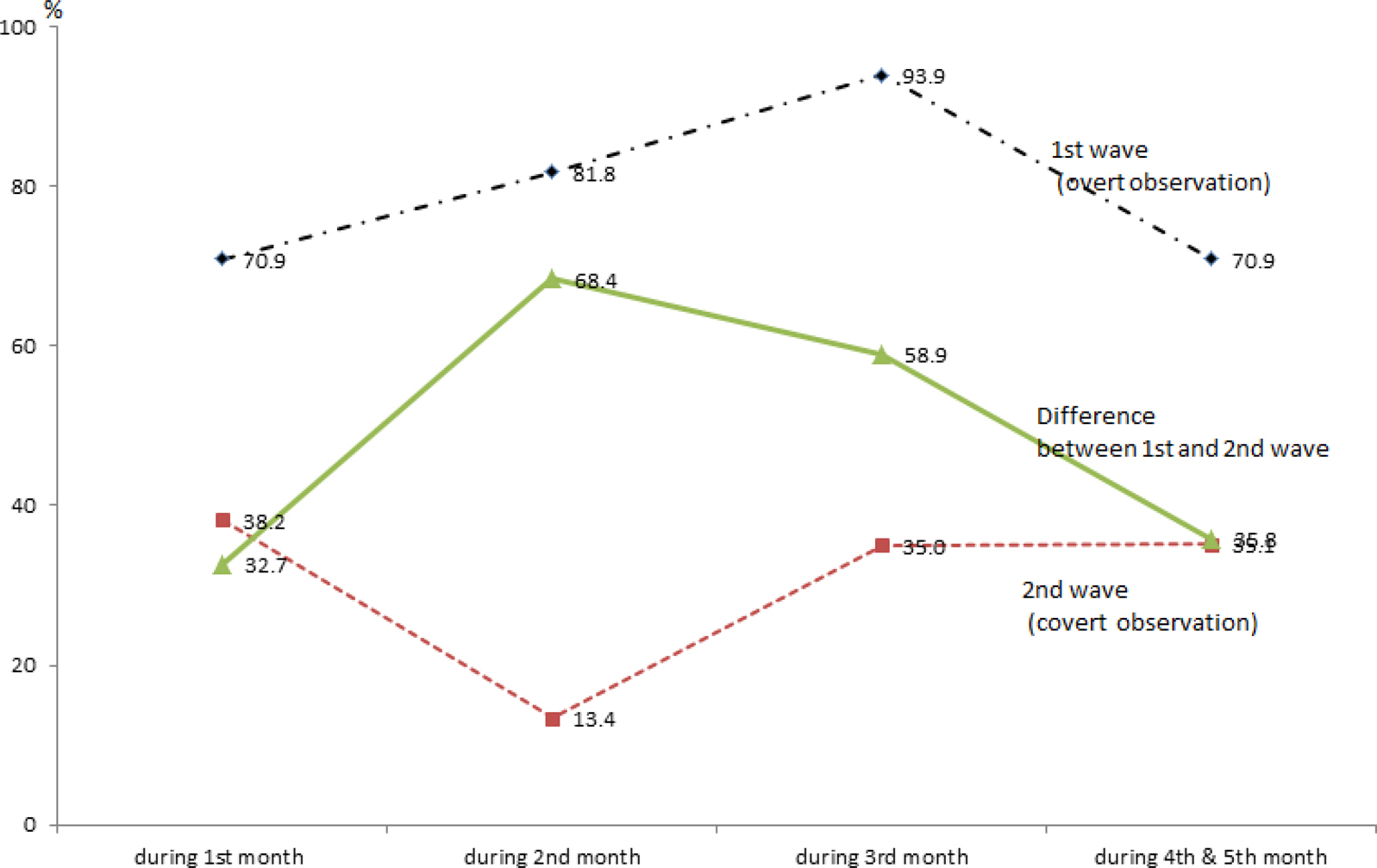Perspect Nurs Sci.
2015 Apr;12(1):7-13. 10.16952/pns.2015.12.1.7.
The Hawthorne Effect on the Adherence to Hand Hygiene
- Affiliations
-
- 1Infection Control Team, Pusan National University Yangsan Hospital, Yangsan, Korea.
- 2College of Nursing, Pusan National University, Yangsan, Korea. jeongis@pusan.ac.kr
- KMID: 2315706
- DOI: http://doi.org/10.16952/pns.2015.12.1.7
Abstract
- PURPOSE
This observational study was aimed to determine the influence of the Hawthorne effect on the adherence to hand hygiene (HH) among healthcare workers (HCWs) in South Korea.
METHODS
HCWs were monitored in 2 periods regarding adherence to HH when there were indications for HH. In first period, HCWs recognized that their behavior of hand hygiene being observed (overt observation), and did not recognize in second period (covert observation).
RESULTS
The overall difference in HH rate between two periods was 45.0% point (77.8% vs 32.8%). There were significant differences between profession but in nurse aids. The differences in HH rate between two periods were 46.1% point in nurses, 29.9% point in physicians, 64.0% in radiologists, 62.5% point in laboratory technicians, 36.4% point in physio-therapist, and 1.0% point in nurse aids. The Hawthorne effect on the adherence to HH lasted more than 3 months.
CONCLUSION
The Hawthorne effect markedly influence on the adherence to HH regardless of profession except nurse aids. Therefore, Hawthorne effect can be useful tool to improve and sustain the adherence to HH among HCWs in South Korea.
Keyword
MeSH Terms
Figure
Cited by 1 articles
-
Hand Hygiene Compliance among Visitors at a Long-term Care Hospital in Korea: A Covert Observation Study
Min Young Jung, JaHyun Kang
J Korean Acad Community Health Nurs. 2019;30(1):99-107. doi: 10.12799/jkachn.2019.30.1.99.
Reference
-
1.Allegranzi B., Pittet D. Role of hand hygiene in healthcare-associated infection prevention. J Hosp Infect. 2009 Aug. 73 (4): 305-15.http://dx.doi.org/10.1016/j.jhin.2009.04.019.
Article2.World Health Organization. WHO guidelines on hand hygiene in health care: First Global Patient Safety Challenge Clean Care Is Safer Care. Geneva: World Health Organization;2009. Available from:. http://www.ncbi.nlm.nih.gov/books/NBK144013/.3.Pittet D., Allegranzi B., Sax H., Dharan S., Pessoa-Silva CL., Donaldson L, et al. Evidence-based model for hand transmission during patient care and the role of improved practices. Lancet Infect Dis. 2006. 6(10):641–52. http://dx.doi.org/10.1016/S1473-3099(06)70600-4.
Article4.Cromer AL., Latham SC., Bryant KG., Hutsell S., Gansauer L., Bendyk HA, et al. Monitoring and feedback of hand hygiene compliance and the impact on facility-acquired methicillin-resistant Staphylococcus aureus. Am J Infect Control. 2008. 36:672–7. http://dx.doi.org/10.1016/j.ajic.2007.12.006.
Article5.Ward MA., Schweizer ML., Polgreen PM., Gupta K., Reisinger HS., Perencevich EN. Automated and electronically assisted hand hygiene monitoring systems: a systematic review. Am J Infect Control. 2014. 42:472–8. http://dx.doi.org/10.1016/j.ajic.2014.01.002.
Article6.Kohli E., Ptak J., Smith R., Taylor E., Talbot EA., Kirkland KB. Variability in the Hawthorne effect with regard to hand hygiene performance in high- and low-performing inpatient care units. Infect Control Hosp Epidemiol. 2009. 30(3):222–5. http://dx.doi.org/10.1086/595692.
Article7.Eckmanns T., Bessert J., Behnke M., Gastmeier P., Ruden H. Compliance with antiseptic hand rub use in intensive care units: the Hawthorne effect. Infect Control Hosp Epidemiol. 2006. 27(9):931–4. http://dx.doi.org/10.1086/507294.
Article8.Gilboy N., Howard PK. Compliance with hand hygiene guidelines. Adv Emerg Nurs J. 2008. 30(3):193–200. http://dx.doi.org/10.1097/01.TME.0000334370.14034.fc.
Article9.Buchanan D., Huczynski A. Organizational behavior. 3rd ed.London: Prentice Hall;1997.10.Hwang SM., Lee RH. Personality as types of self perception of others' evaluation: how Koreans perceive personality. Scientific Study of Subjectivity: Q Methodology and Theory. 2010. 20:121–43.11.Arenas MD., Sánchez-Payá J., Barril G., García-Valdecasas J., Gorriz JL., Soriano A, et al. A multicentric survey of the practice of hand hygiene in haemodialysis units: factors affecting compliance. Nephrol Dial Transplant. 2005. 20(6):1164–71. http://dx.doi.org/10.1093/ndt/gfh759.
Article12.Harbarth S., Pittet D., Grady L., Zawacki A., Potter-Bynoe G., Samore MH, et al. Interventional study to evaluate the impact of an alcohol-based hand gel in improving hand hygiene compliance. Pediatr Infect Dis J. 2002. 21(6):489–95.
Article13.Feil PH., Grauer JS., Gadbury-Amyot CC., Kula K., McCunniff MD. Intentional use of the Hawthorne effect to improve oral hygiene compliance in orthodontic patients. J Dent Educ. 2002. 66(10):1129–35.
Article14.Pittet D., Mourouga P., Perneger TV. Compliance with handwashing in a teaching hospital. Ann Intern Med. 1999. 130(2):126–30. http://dx.doi.org/10.7326/0003-4819-130-2-199901190-00006.
Article15.Alsubaie S., Maither A., Alalmaei W., Al-Shammari AD., Tashkan-di M., Somily AM, et al. Determinants of hand hygiene noncompliance in intensive care units. Am J Infect Control. 2013. 41(2):131–5. http://dx.doi.org/10.1016/j.ajic.2012.02.035.
Article
- Full Text Links
- Actions
-
Cited
- CITED
-
- Close
- Share
- Similar articles
-
- The Hawthorne Effect between Covert and Overt Observations in the Monitoring of Hand Hygiene Adherence among Healthcare Personnel at Coronary Care Unit and Cardiac Surgery Intensive Care Unit
- Factors Influencing Hand Hygiene Adherence among Hospitalized Adults in South Korea
- The Effect of a Scenario based Hand Hygiene Education Program on Hand Hygiene Knowledge, Hand Hygiene Perception, Hand Hygiene Compliance and Hand Hygiene Method in Nursing Students
- Improved Hand Hygiene Compliance is Associated with the Change of Perception toward Hand Hygiene among Medical Personnel
- Comparison of the Degree of Bacterial Removal by Hand Hygiene Products


